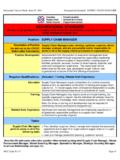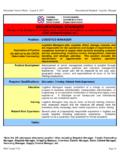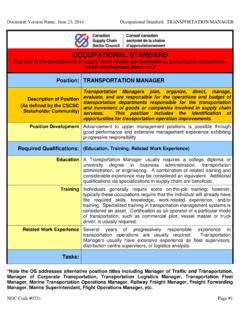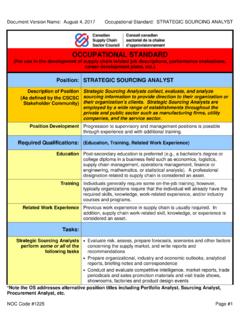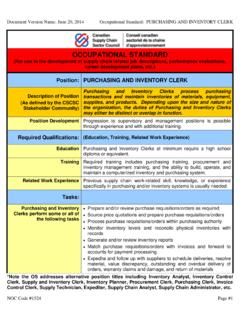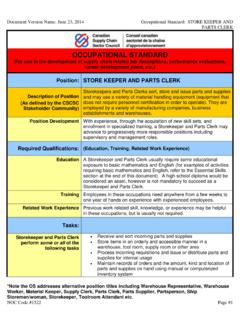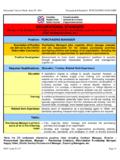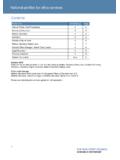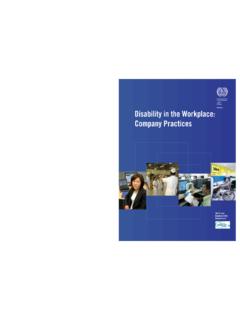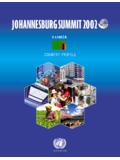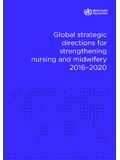Transcription of STRATEGIC HUMAN RESOURCES STUDY OF THE …
1 STRATEGIC HUMAN RESOURCES STUDY OF THE SUPPLY CHAIN SECTORFINAL REPORT| FALL 2005 CLSC 83702 English Cover 10/4/05 10:50 AM Page 1 The opinions and interpretations in this publication are those of the author and do not necessarily reflect those of the Government of Canada. Copyright 2005 Canadian Logistics Skills Committee (CLSC). All rights reserved. The use of any part of this publication, whether it is reproduced, stored in a retrieval system, or transmitted in any form or by any means (including electronic, mechanical, photographic, photocopying or recording), without the prior written permission of CLSC is an infringement of copyright law. For more information, contact: Canadian Logistics Skills Committee 6379 Main Street, Box 211 Stouffville, Ontario L4A 7Z5 Telephone: 416-648-3413 Fax: 905-640-9583 Email: Or visit the CLSC website, at: Published: October 2005 Aussi disponible en fran ais This project is funded by the Government of Canada's Sector Council Program.
2 ISBN 0-9739397-0-2 STRATEGIC HUMAN RESOURCES STUDY of the Supply Chain Sector iii Acknowledgements The Canadian Logistics Skills Committee sector STUDY was made possible by the following: CLSC Steering Committee members: Serge Alexandre Domtar James Bergeron Lafarge Canada Inc. Colonel F. Michael Boomer national Defence Headquarters Donald Borsk Supply Chain Management Inc. John F. Chipperfield Bellville Rodair International Tracy Clayson In Transit Personnel Inc. Bryan Cox Source Medical Corporation Hanaa El-Alfy Ontario Ministry of Economic Development and Trade Darren Gorman Transport Canada Dwayne Hihn BAX Global Canada Frances Humphreys Laurier School of Business & Economics Louis Joncas Thales Avionique Canada Inc. Susan Krausz Humber Institute of Technology & Advanced Learning Stephan Lauzon 4L2 Consulting Group Philippe Leblanc Metro Canada Logistics Paul Lobas ITN Logistics Group Drake MacDonald SMART Technologies Pierre Massicotte L'Or al Canada Colonel Mark Matheson national Defence Headquarters Craig McLean UPS Supply Chain Solutions John McMurray Colgate-Palmolive Canada Inc.
3 Al Norrie SAP Canada Inc. Michel Ravacley The Hockey Company Philippe Richer Industry Canada Pierre Rodrigue Gouvernement du Qu bec Derrick Ronayne The Brick Warehouse LP Dale Ross Effem Inc. (retired) Deborah Shaman HUMAN RESOURCES and Skills Development Canada Con Taillon United Farmers of Alberta Branko Tosic Danex Systems Limited Project Manager: Kim Biggar CLSC Research Consultants: Deloitte Inc.: Ian Cullwick Engagement Partner Cathy Frederick Project Manager Yves Gascon Industry Specialist Paul Marc Frenette Jennifer Leech Scottworks: Dr. Jeremy Jackson Julie Desaulniers iv STRATEGIC HUMAN RESOURCES STUDY of the Supply Chain Sector Acknowledgements continued The Canadian Logistics Skills Committee wishes to thank the following associations for their support of this STUDY : APICS - The Association for Operations Management Association of Canadian Community Colleges Canadian International Freight Forwarders Association Canadian Institute of Traffic and Transportation The Logistics Institute Purchasing Management Association of Canada Supply Chain & Logistics Canada Lastly, we thank the many individuals who participated in this STUDY , by completing surveys, and taking part in focus groups, interviews and roundtables.
4 Without your input, this STUDY could not have been completed. STRATEGIC HUMAN RESOURCES STUDY of the Supply Chain Sector v Table of Contents Executive Summary ..1 20 Module 1 .. 22 Sector 22 Policies and Regulations .. 32 36 International Analysis .. 39 Module 2 .. 42 Application of Existing Technology .. 42 Emerging Technologies and Their Impact .. 48 Trends Driven by 50 HUMAN RESOURCES and Skill Development Implications .. 52 Module 3 .. 58 Current Employment 58 Logistics Occupations .. 65 Skill Requirements .. 68 Work Environment .. 74 Career Path 78 Module 4 .. 82 Historical Sector Growth .. 82 Anticipated Employment Demand .. 83 Workforce 91 Module 5 .. 100 Current Development Programs/Training Practices .. 100 Assessment of Education and Training .. 108 Barriers to Training .. 111 International Practices.
5 112 HUMAN RESOURCES Issues .. 114 Recruitment and Retention .. 117 Compensation .. 124 Career Progression .. 125 Emerging HUMAN RESOURCES Strategies .. 128 Module 6 .. 131 Key HUMAN RESOURCES 131 SWOT Analysis .. 133 Recommendations .. 137 Implementation Considerations .. 142 Conclusion .. 142 vi STRATEGIC HUMAN RESOURCES STUDY of the Supply Chain Sector Appendices Appendix A Steering Committee Members Appendix B Methodology STUDY Participants Appendix C Participant Profile Appendix D List of Employer Participants Appendix E List of Employee Participant Organizations Appendix F List of Educational Institution Participants Appendix G List of Association Participants Appendix H List of Roundtable Participants Interview and Focus Group Guides Appendix I Employer Interview Guide Appendix J Employee Focus Group Guide Appendix K Association Interview Guide Appendix L Steering Committee Members Interview Guide Survey Questionnaires Appendix M Employer Questionnaire Appendix N Employee Questionnaire Appendix O Educational Institution Questionnaire Appendix P Student Questionnaire Inventories Appendix
6 Q List of Affiliated Associations Appendix R Association Program & Certification Inventory Appendix S College/University Logistics Program Inventory Appendix T Employee NOC Profiles Appendix U Education/Certification Required by Employers Appendix V Program Details by Academic Institution Other Appendix W List of Supply Chain Sector NOC Codes (Terms of Reference) Appendix X References Appendix Y Glossary STRATEGIC HUMAN RESOURCES STUDY of the Supply Chain Sector 1 Executive Summary Introduction The findings of the Canadian Logistics Skills Committee s national supply chain STRATEGIC HUMAN RESOURCES STUDY present a picture of a sector in need of a vision and STRATEGIC leadership. Survey data suggests that many HUMAN RESOURCES challenges could be overcome by connecting a fragmented sector, increasing awareness of supply chain occupations, and working with educators at all levels to develop supply chain programming that addresses the sector s evolving needs.
7 The STRATEGIC HUMAN RESOURCES STUDY of the Supply Chain Sector, a report funded by the Government of Canada s Sector Council Program, builds upon, and continues the work initiated by, the Lean Logistics Technology Roadmap project. It is an in-depth national research STUDY aimed at developing a common industry vision for, and a co-operative approach to address, the current and future HUMAN RESOURCES challenges of the supply chain sector. This STUDY was conducted under the guidance of the Canadian Logistics Skills Committee (CLSC), a national committee comprising industry, academic and provincial-government representatives, and in partnership with HUMAN RESOURCES and Skills Development Canada, Industry Canada and Transport Canada. The CLSC is mandated to assess technologies, innovations and conditions that have the greatest impact on the supply chain sector, and to develop a STRATEGIC HUMAN RESOURCES action plan for Canadian industry and academia.
8 A review of the major HUMAN RESOURCES challenges in the sector reveals a limited pool of skilled employees and the need to develop skill sets to cope with emerging technologies and a global marketplace. In addition, the sector must overcome a general lack of awareness and understanding of the supply chain sector and its occupations. Students, new workforce entrants and those in career transition typically do not enter the supply chain sector by design usually by accident simply because they do not know it exists. In order for the sector to attract, develop and retain the talent it requires, it must compete for attention in an environment where other sectors and industries have already, or are about to, initiate awareness and recruitment campaigns to address their talent shortage. Attraction and retention of talent, particularly knowledge workers, are vital to the sector s ability to focus on improvements to the Canadian supply chain.
9 This is of paramount importance, as supply chain performance directly impacts the costs and effectiveness of Canadian industry and, therefore, Canadian competitiveness on a national and global scale. STUDY findings are based on input from a broad representation of supply chain sector participants, including employers, employees, academia, students and associations, as well as past studies and secondary sources of information. As such, the general approach to this STUDY comprised both primary and secondary research components. Key data gathering activities included the following: Review of secondary research employing publicly available studies, articles and data; Interviews with Canadian Logistics Skills Committee members; Surveys administered to industry employers, employees, academic institutions and students; 2 STRATEGIC HUMAN RESOURCES STUDY of the Supply Chain Sector Focus groups and interviews with industry participants (employers and employees); Interviews with a selection of associations; and Roundtable discussions with industry and academic leaders.
10 The scope of topics covered ranges from general industry characteristics and trends to specific HUMAN RESOURCES challenges and practices. Key areas explored include: The current and future business environment of the supply chain sector; The impact of technology on the sector and HUMAN RESOURCES skills requirements; The current and future employment profile of occupations in the sector; The current and future skilled worker demand and supply; The current levels and types of supply chain training and future needs; and Current HUMAN RESOURCES strategies and practices. In addition, the STUDY investigates regional and organization size differences across various factors within the scope of the STUDY in order to identify if any specific trends or needs are present. STUDY results are summarized in the body of this report and structured around the following six modules: Module 1 The Evolving Economic, Business and Regulatory Environment Module 2 The Impact of Technology and other Change Drivers Module 3 Employment Analysis Module 4 Skill Demand and Forecast Module 5 Recruitment, Training, Development & Retention Module 6 Recommendations It is intended that the findings of this STUDY be used to create a HUMAN RESOURCES action plan for Canadian industry and academia, and provide small and medium-sized organizations with recommendations they can adopt independently.
